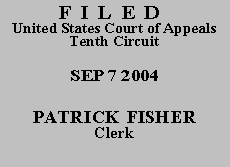

| WALTER B. MIECH,
Plaintiff-Appellant, v. SHERIDAN COUNTY, WYOMING, Defendant-Appellee. |
|
Walter B. Miech brought this wrongful discharge action asserting that Sheridan County, Wyoming, violated its controlling personnel policy when it terminated his position as a firefighter.(1) A jury entered a defense verdict. Miech appeals, arguing that one of the jury instructions was improper and misleading. We have jurisdiction pursuant to 28 U.S.C. § 1291, and we affirm.
Miech was employed as a full-time firefighter by Sheridan County from 1983 until his position was eliminated in 1999 as a result of a consolidation agreement between Sheridan County and the City of Sheridan, intended to "provid[e] emergency services . . . in the most efficient and effective manner . . . at a lower cost to the county and city taxpayer." Aplee. Supp. App. at 44. The agreement dissolved the County fire department, created additional City firefighter positions, and gave qualifying County firefighters the opportunity to apply for the City positions. The City, however, required its firefighters to live within a certain radius of the City limits. Miech, who lived approximately one mile outside of the radius, did not apply.
Instead, he applied for a maintenance position at the Sheridan County Airport. His application was initially rejected, but later the County offered to hire him in the position as an at-will employee, with a lower pay than his firefighter job and without reinstatement of his seniority, sick leave, or vacation time. He declined the offer and filed this lawsuit, alleging a violation of his due process rights, breach of an implied contract of public employment, and negligence.
The parties engaged in lengthy motion practice, including the certification of a question to the Wyoming Supreme Court. See Miech v. Sheridan County, 59 P.3d 143 (Wyo. 2002). After that, Miech's case went to trial on three issues: (1) whether the policy amounted to an implied contract of employment; (2) whether the County breached the contract, thereby infringing his due process rights; and (3) damages. The implied contract theory was based on Miech's contention that the termination of his employment violated the applicable County personnel policy because it did not arise from any of the six specific reasons for "Separation for Cause" listed in the policy: discipline, fraud, poor performance, resignation, retirement, and reduction-in-force. Aplt. App. at 39-40. The County claimed that Miech's job was lost in a reduction-in-force, caused by "lack of funds or the elimination of a position(s)," and was therefore consistent with the policy. Id.; see also Aplee. Supp. App. at 42 (defining reduction-in-force as "[t]he separation of an employee, or employees, due to a reduction of funding, functions or other reasons not related to poor performance, discipline, retirement or resignation"). The jury determined that the personnel policy created an implied contract, but that the County did not breach the contract.
In this appeal, Miech asserts that Jury Instruction No. 11, which provided a legal definition of "cause" for termination, was improper. Because Miech objected to the instruction at trial, we review his challenge "de novo . . . to determine whether, considering the instructions as a whole, the jury was misled. We reverse only when we have substantial doubt that the jury was fairly guided." Wilson v. Muckala, 303 F.3d 1207, 1214 (10th Cir. 2002) (quotation and citations omitted).
Instruction No. 11 defined "cause" as "fair and honest reasons, regulated by good faith on the part of the employer, that are not trivial, arbitrary or capricious, unrelated to business needs or goals, or a pretext." Aplt. App. at 26. Miech does not argue that the definition is incorrect. Indeed, the instruction essentially quoted a statement of the Wyoming Supreme Court. Life Care Ctrs. of Am., Inc. v. Dexter, 65 P.3d 385, 392 (Wyo. 2003) (further quotation omitted). Rather, he claims that, in his case, use of the definition broadened the permissible reasons for termination of his employment, leading the jury to believe that he could have been discharged for reasons not listed in the personnel policy.
The Wyoming Supreme Court "ask[s] the trial court to apply the good faith standard for review of employer firing." This standard is "[i]n addition to applying the terms of the handbook in determining whether there was cause for termination." Life Care Ctrs. of Am., Inc., 65 P.3d at 392. In context, Instruction No. 11 explained that Wyoming law imposed a requirement of good faith on the part of the County during the consolidation process. Another instruction informed the jury that defendant could be liable if the termination of Miech's employment "did not comply with a material provision of the employment contract." Aplt. App. at 25. After examining the instructions as a whole, we see no merit in Miech's argument.
Moreover, it is plain from the record that it was reasonable for a jury to conclude that the consolidation amounted to a reduction-in-force and, as such, satisfied the "for cause" standard of the personnel policy. Without a doubt, the instructions provided fair legal guidance to the jury.
The judgment of the district court is AFFIRMED.
Entered for the Court
Circuit Judge
*. This order and judgment is not binding precedent, except under the doctrines of law of the case, res judicata, and collateral estoppel. The court generally disfavors the citation of orders and judgments; nevertheless, an order and judgment may be cited under the terms and conditions of 10th Cir. R. 36.3.
1. We note that the parties also spell plaintiff's last name as Meich, rather than Miech. For purposes of consistency with the district court's docket sheet, we use the latter spelling in this order and judgment.